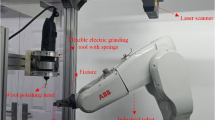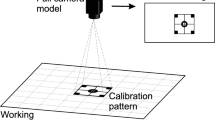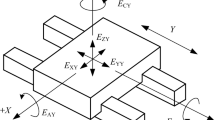Abstract
Calibration in the robot-assisted belt grinding of complex blades is regarded as one of the key bottlenecks of measurement accuracy. To enhance the accuracy, a TCP-based (tool center point) calibration method is proposed in this paper to calibrate the relationship between the precalibrated 3D laser scanner and the robot end-effector by using criterion spheres as the calibration object. Based on the description of the robot-scanning system from the perspectives of coordinates and scanner measurement modes, the calibration strategies on translational and rotational motions of the robot are provided to determine the translation vector and the orientation matrix. Calibration experiments on the criterion sphere are performed, both the calibration errors (positioning error and orientation error) and sphere fitting error are calculated. A typical case on the robotic belt grinding of 84K-2R1 aviation blade is conducted to validate the calibration results. Finally, the key factors influencing the calibration accuracy are analyzed. It has been demonstrated that the TCP-based calibration method proposed is effective, concise, and time-saving, and can be widely applied in the robot-assisted belt grinding operation.
Similar content being viewed by others
References
Zhu D, Luo S, Yang L, Chen W, Yan S, Ding H (2015) On energetic assessment of cutting mechanisms in robot-assisted belt grinding of titanium alloys. Tribol Int 90:55–59
Zha XF, Chen XQ (2004) Trajectory coordination planning and control for robot manipulators in automated material handling and processing. Int J Adv Manuf Technol 23(11):831–845
Zhao P, Shi Y (2014) Posture adaptive control of the flexible grinding head for blisk manufacturing. Int J Adv Manuf Technol 70(9):1989–2001
Je HW, Baek JY, Lee MC (2011) Current based compliance control method for minimizing an impact force at collision of service robot arm. Int J Precis Eng Man 12(2):251–258
Fang HC, Ong SK, Nee AYC (2013) Orientation planning of robot end-effector using augmented reality. Int J Adv Manuf Technol 67(9):2033–2049
Song Y, Liang W, Yang Y (2012) A method for grinding removal control of a robot belt grinding system. J Intell Manuf 23(5):1903–1913
Gong C, Yuan J, Ni J (2000) Nongeometric error identification and compensation for robotic system by inverse calibration. Int J Mach Tool Manu 40(14):2119–2137
Sun Y, Giblin DJ, Kazerounian K (2009) Accurate robotic belt grinding of workpieces with complex geometries using relative calibration techniques. Robotic Cim-Int Manuf 25(1):204–210
Majarena AC, Santolaria J, Samper D, Aguilar JJ (2013) Analysis and evaluation of objective functions in kinematic calibration of parallel mechanisms. Int J Adv Manuf Technol 66(5):751–761
Durupt A, Remy S, Ducellier G (2011) Reverse engineering of a piston using knowledge based reverse engineering approach. In: Bernard A (ed) Global product development. Springer, Berlin Heidelberg, pp. 683–690
Fan KC, Lee MZ, Mou JI (2002) On-line non-contact system for grinding wheel wear measurement. Int J Adv Manuf Technol 19(1):14–22
Conte J, Majarena AC, Aguado S, Acero R, Santolaria J (2016) Calibration strategies of laser trackers based on network measurements. Int J Adv Manuf Technol 83(5):1161–1170
Zhan Q, Wang X (2012) Hand–eye calibration and positioning for a robot drilling system. Int J Adv Manuf Technol 61(5):691–701
Kosarevsky S (2010) Practical way to measure large-scale 2D parts using repositioning on coordinate-measuring machines. Measurement 43(6):837–841
Gerbino S, Del Giudice DM, Staiano G, Lanzotti A, Martorelli M (2015) On the influence of scanning factors on the laser scanner-based 3D inspection process. Int J Adv Manuf Technol. doi:10.1007/s00170-015-7830-7
Abderrahim M, Khamis A, Garrido S, Moreno L (2007) Accuracy and calibration issues of industrial manipulators. In: Huat LK (ed) Industrial robotics: programming, simulation and applications. Pro Literatur Verlag, Germany, pp. 131–146
Dombre E, Khalil W (2007) Robot manipulators: modeling, performance analysis and control. Wiley
Muruganantham C, Jawahar N, Ramamoorthy B, Giridhar D (2009) Optimal settings for vision camera calibration. Int J Adv Manuf Technol 42(7):736–748
Hartley R, Zisserman A (2003) Multiple view geometry in computer vision. University Press, Cambridge, pp. 168–183
Li D, Shen L, Xie D, Zhang L (2012) Camera linear calibration algorithm based on features of calibration plate. Advances in Electric and Electronics 155:689–697
Leali F, Vergnano A, Pini F, Pellicciari M, Berselli G (2014) A workcell calibration method for enhancing accuracy in robot machining of aerospace parts. Int J Adv Manuf Technol. doi:10.1007/s00170-014-6025-y
Johansson H, Runesson K, Larsson F (2007) Calibration of a class of non-linear viscoelasticity models with adaptive error control. Comput Mech 41(1):107–119
Seo JK, Hwang YH, Hong HK (2004) Structure and motion recovery using two step sampling for 3D match move. In: Monroy R, Arroyo-Figueroa G, Sucar LE, Sossa H (eds) MICAI 2004: advances in artificial intelligence 2972:652–661. Springer, Berlin Heidelberg
Jiang ZT, Liu SC (2011) The self-calibration of varying internal camera parameters based on image of dual absolute quadric transformation. In: Information and Automation, vol 86. Springer Berlin Heidelberg, pp 452–461
Li J, Zhu J, Guo Y, Lin X, Duan K, Wang Y, Tang Q (2008) Calibration of a portable laser 3-D scanner used by a robot and its use in measurement. Opt Eng 47(1):017202–017202
Ren Y, Yin S, Zhu J (2012) Calibration technology in application of robot-laser scanning system. Opt Eng 51(11):–114204
Yin S, Ren Y, Zhu J, Yang S, Ye S (2013) A vision-based self-calibration method for robotic visual inspection systems. Sensors 13(12):16565–16582
Chang WC, Wu CH (2015) Eye-in-hand vision-based robotic bin-picking with active laser projection. Int J Adv Manuf Technol. doi:10.1007/s00170-015-8120-0
Li WL, Xie H, Zhang G, Yan SJ, Yin ZP (2015) Hand-eye calibration in visually-guided robot grinding. IEEE T Cybernetics. doi:10.1109/TCYB.2015.2483740
Zhao Y (2009) Robot grinding blade key technology research. Jilin University, Ph.D. Thesis. (in Chinese)
Chen J, Kang X, Liu Y, Wang ZJ (2015) Median filtering forensics based on convolutional neural networks. IEEE Signal Proc Let 22(11):1849–1853
Zhang Z, Yuan L (2012) Building a 3D scanner system based on monocular vision. Appl Opt 51(11):1638–1644
Krooks A, Kaasalainen S, Hakala T, Nevalainen O (2013) Correction of intensity incidence angle effect in terrestrial laser scanning. ISPRS Ann Photogramm Remote Sens Spat Inf Sci 2:145–150
Brandstötter M, Gruber C, Hofbaur M (2015) A method to estimate the encoder dependent repeatability of general serial manipulators. In: Recent Advances in Mechanism Design for Robotics. Springer International Publishing, pp 99–110
Li J, Chen M, Jin X, Chen Y, Dai Z, Ou Z, Tang Q (2011) Calibration of a multiple axes 3-D laser scanning system consisting of robot, portable laser scanner and turntable. Optik 122(4):324–329
Author information
Authors and Affiliations
Corresponding author
Rights and permissions
About this article
Cite this article
Xu, X., Zhu, D., Zhang, H. et al. TCP-based calibration in robot-assisted belt grinding of aero-engine blades using scanner measurements. Int J Adv Manuf Technol 90, 635–647 (2017). https://doi.org/10.1007/s00170-016-9331-8
Received:
Accepted:
Published:
Issue Date:
DOI: https://doi.org/10.1007/s00170-016-9331-8




